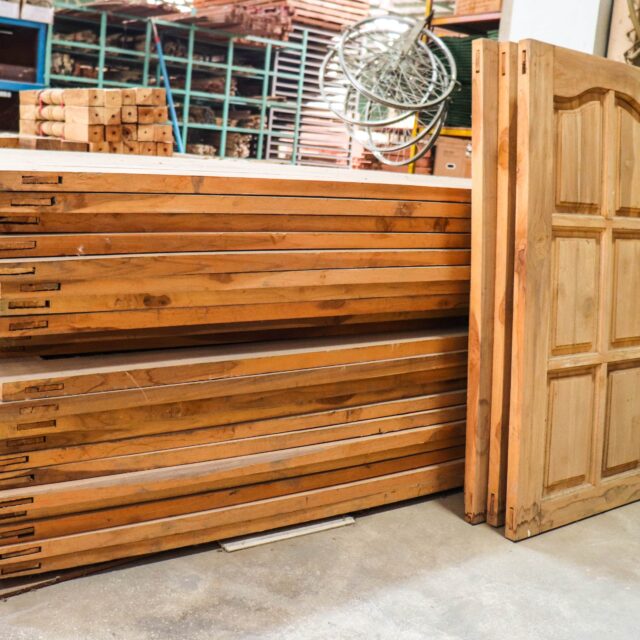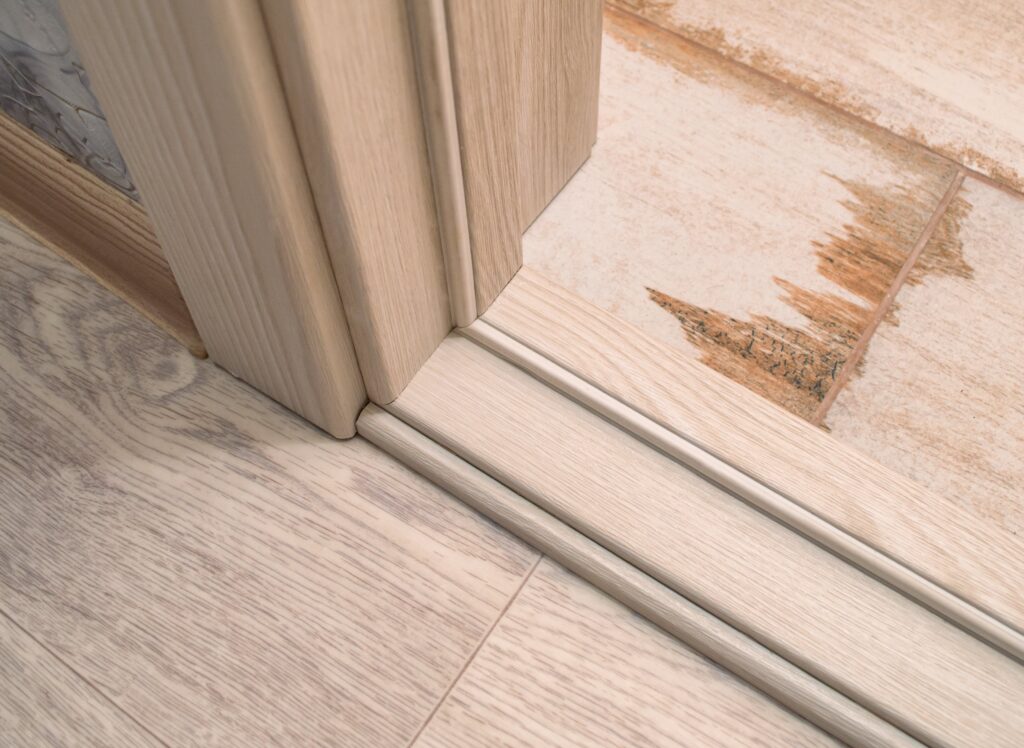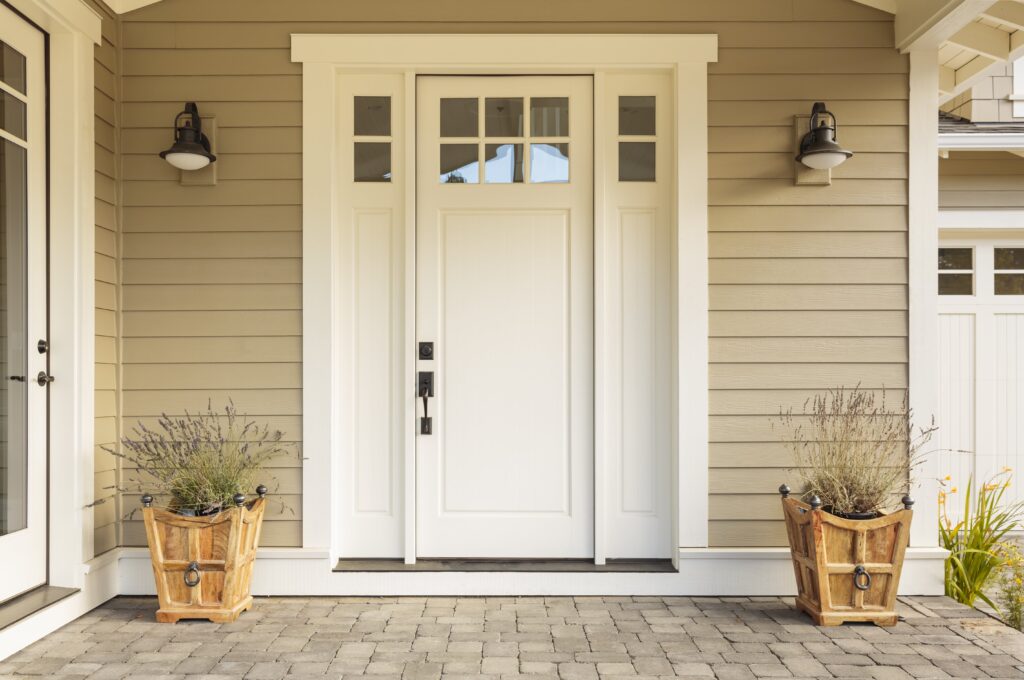Selecting the Right Materials For Your Project: Best Materials for Doors Edition

- Written by: jlbmdev

A door isn’t just the entryway into your home. It welcomes you and any guests inside, protects you from environmental elements, and gives you a sense of security. So picking the correct door is a big decision with lots of options on the market. How do you know which one is right for you?
We’ll be continuing our series on how to choose the right materials for your project and focus on the best materials for doors.
In this second installment, we’ll go over the different types of door materials and styles. So by the time you’ve finished reading, you’ll be able to be confident in your choice for your home.
Many different factors go into choosing a door. An important question to ask is what do you want your door made from? Below are the most common door materials and the pros and cons of each.
Fiberglass doors are known for their strength and durability. They can mimic the look of wood and come in a variety of finishes. Another benefit of fiberglass doors is that they’re typically low maintenance. They’ll usually need to be cleaned with a damp cloth and that’s it.
These doors are resistant to moisture, rot, and insects, making them a good choice for exterior use. They also feature an insulated core that’s designed to give you better protection from the heat and cold.
Wood is a traditional and versatile choice for doors since it offers a classic aesthetic and can be stained or painted to match your interior or exterior decor.
Different types of wood, such as oak, mahogany, and cherry, provide varying levels of durability and appearance. Wood doors can be made of solid wood and can be quite heavy and expensive; while engineered wood doors offer cost-effective alternatives with good durability.
Wood is considered a good insulator so they are a good option if you’re trying to keep your energy costs down.
Composite doors usually have a solid timber core with other materials such as uPVC, laminate, or even GRP (Glass Reinforced Plastic—also known as fiberglass) surrounding it.
They’re a low-maintenance option since they’re resistant to weather and most forms of general wear and can be less expensive than wooden doors, but they still aren’t a cheap option. Also, composite doors are harder to paint if they get damaged or you want to change the color.
While previously used almost exclusively for commercial use, steel doors are now being used for residential homes, mostly as exterior doors. This is in part due to their strength and durability.
Steel doors can be painted or coated to resist rust and corrosion. Since this is the only maintenance required, steel doors are considered a low-maintenance option.
They also provide excellent insulation properties and can help keep in the warm or cool air in your home. This can help you save money.
These doors are lightweight and low-maintenance. They aren’t prone to rusting like other metal doors because they have a baked enamel finish. They are commonly used for sliding patio doors but can also be used as interior door frames on glass doors.
While not as energy-efficient as other materials, they are resistant to corrosion and can be a good choice for coastal areas.
Glass doors are often used for sliding or French doors to let natural light flow into your space and create openness. The glass door frames can be made of several different kinds of material including wood, fiberglass, and vinyl. A benefit of glass doors is that they can be used as either interior or exterior doors.
While people might think that glass doors wouldn’t be green, they can be made energy-efficient with double or triple glazing and low-emissivity coatings. However, something to consider is the thicker the glass, the higher the price goes.
Since they’re made of glass, they may require more maintenance in terms of cleaning and privacy considerations.
Ultimately, it comes down to several things, including your budget and your personal preferences. If you live in an area that has scenic views and lots of natural light, then a glass door would be a good option to take advantage of these elements. If you need more of a low-maintenance option that won’t break the bank, then a fiberglass door would work for you.
There are benefits and drawbacks to each option and doing some research about your options before you start looking at doors can help answer your questions. That’s why we’ve put together this cheat sheet so you can get a quick overview of your options and what will fit your wants and needs the best.
| Type | Cost | Interior Use | Exterior Use | Maintenance |
|---|---|---|---|---|
| Fiberglass | $ | ✔ | ✔ | Low |
| Wood | $$ | ✔ | ✔ | High |
| Composite Wood | $$ | ✔ | ✔ | Low |
| Aluminum | $ | ✘ | ✔ | Low |
| Steel | $$ | ✘ | ✔ | Low |
| Glass | $$ | ✔ | ✔ | High |

Door sills, also known as doorsteps or a threshold, are the horizontal part that forms the bottom section of a door frame or the bottom edge of a door. They perform several functions from structural support to sealing and weatherproofing, to decorative functions.
Door sills are typically made from durable materials that can withstand daily use and exposure to the elements. Common materials for door sills include wood, aluminum, steel, and various types of composite materials. A door sill doesn’t need to match your door material so you have some freedom in your material selection.
Some materials, like different woods, are higher maintenance since they can crack and will need to be replaced, while others like steel and aluminum will last longer.
A door isn’t just a door. There are several different styles you can choose depending on your style and home.
Barn doors have become more popular over the last few years. They’re mostly used in farmhouses or rustic aesthetics. Barn doors are typically unfinished-looking sliding doors mounted on the exterior of a track. They’ve been used as closet, pantry, or bathroom doors.
A Dutch door, also known as a stable door or half door, is where the door is divided horizontally, allowing the top and bottom parts to open independently. They were originally known as double-hung doors. They’re often used in kitchens or as exterior doors. This allows homeowners to take advantage of the breeze but keep animals and dirt out of the house.
French doors are typically hinged double doors with glass panes. They are often used for interior room dividers or exterior access to patios and gardens. French doors are perceived as an upgrade when people are looking for a new home.
These are the most common types of interior and exterior doors—most of the ones you see are hinged doors. They swing open and closed on hinges attached to the door frame. Hinged doors come in single and double configurations. Double-hinged doors are primarily used in commercial settings but can be found in residential homes.
Pocket doors slide into a hidden wall pocket when opened, saving space and creating a seamless transition between rooms. One thing to keep in mind if you want to add pocket doors is to have enough wall space to add the pocket for the door to slide into.
These doors consist of large glass panels that slide horizontally on tracks. They are popular for access to outdoor spaces and can provide an unobstructed view. A drawback to sliding doors is that they can let in a lot of sunlight, raising the temperature in the room. You can combat this by making sure the glass is double-paned to help keep the heat out and adding drapes to the room.
A storm door provides an outer layer of protection to your existing door. They also allow more light and ventilation into your home. They can also be interchangeable with screen doors so it becomes dual purpose. You can let light in the winter without letting cold air in and during the summer, use the screen to help keep it cool.

Before you decide on a door, there are a few questions to ask yourself that might change your final decision.
A question you can ask is “Where is your door located—is it an interior or exterior door?” It seems like an obvious question but certain door materials are better suited for interior use versus exterior use.
Next, if it’s an interior door, narrow down the specific location of the door. Is it a kitchen or a bedroom?
Finally, think about your family’s lifestyle and where you live. Is it a door where it can be damaged either by the weather or by your family’s normal wear and tear? For example, it might not be the best idea to put glass doors in an area where children are playing or rough-housing.
Doors can be deceptively expensive. You might initially think the price is good but that’s only for one door and most projects call for multiple doors. See how many doors you’ll need with your project since the overall cost can go up quickly.
Remember the adage, “measure twice, cut once?” Well, it applies to doors, too. Measure your door opening and see how much room you have available so you buy the correct door for the space.
You also need to measure your space for the type of door you want. French doors won’t work if you only have space for a single-hinged door. Or if you want a sliding barn door but don’t have the corresponding wall space.
Is it because the door is damaged and needs to be replaced? Have you changed your interior design and need doors to match?
Or are you looking to resell the home and you are trying to increase your resale value? It won’t be an obvious feature buyers notice but it will add to the overall feel of the home and help buyers see the value.
The “why” question can affect several other questions. If you’re just replacing a door for style reasons, your budget might be lower. If the door is damaged then you might want to spend a little more to get a more durable product.
Having so many options can be confusing and knowing where to start can quickly overwhelm you. By working with the experts here at J&L Building Materials, we can show you all your door options and help you select the right door for your home and budget.
Another benefit when you work with J&L is if you decide that installing a door is out of your skillset, we can help you find a contractor to help finish your project.